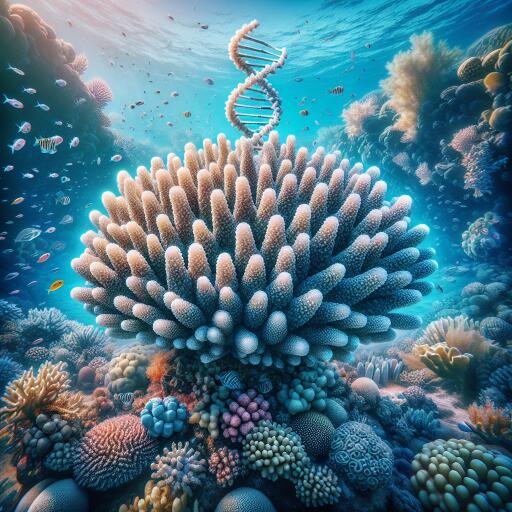A Draft Genome Assembly of the Reef-Building Coral Acropora hemprichii from the Central Red Sea
In the quest to understand the genomic foundations of thermal resilience, researchers have created a draft genome for the stony coral Acropora hemprichii using a combination of short- and linked-read sequencing. The resulting assembly has a size of 495.6 Mb, a scaffold N50 of 1.38 Mb, and identifies 99.6% of BUSCO genes, with 93.7% complete and 5.9% fragmented. Notably, this is the inaugural draft genome assembly of an Acropora species native to the Red Sea, one of the planet’s warmest ecosystems.
Acropora hemprichii, a vital coral species in the Red Sea, has captured scientific interest due to its dominance on shallow reef slopes. This coral’s natural habitat spans the Red Sea and the Indian Ocean, where its distinct blue hue makes it a recognizable presence. Many physiological studies have centered around A. hemprichii, uncovering its association with diverse bacterial communities that swiftly adapt to changing environments. This adaptability potentially elucidates its prevalence across the challenging conditions of the Red Sea.
The assembly’s high contig and scaffold N50 values present a valuable opportunity for evolutionary comparisons with other coral genomes currently available, shedding light on the genetic mechanisms underlying coral resilience.
Sample Collection and DNA Extraction
The research commenced with the collection of a colony of Acropora hemprichii from the Abu Shosha reef in the central Red Sea on March 2, 2019. The colony was brought to the Coastal and Marine Resources Core Lab (CMOR) at KAUST, Saudi Arabia, where it was maintained in an aquarium system mimicking natural seawater conditions. One month later, a fresh nubbin from the colony was preserved for analysis.
Using DESS buffer, the coral tissue was extracted and processed. The resultant slurry was homogenized, and the DNA was isolated for extraction. High molecular weight genomic DNA (HMW gDNA) was then procured using the Qiagen genomic tip 100/g kit.
Library Construction and Sequencing
The genomic DNA integrity was verified through agarose gel electrophoresis and assessed for concentration with a Qubit dsDNA assay. After generating necessary DNA quantities, a 10x Chromium sequencing library was prepared and sequenced using HiSeq4000 technology.
Additional paired-end libraries were created, utilizing 1 µg DNA fragmented by Adaptive Focused Acoustic Technology to achieve overlapping paired-end reads crucial for DISCOVAR de novo assembly. The resulting libraries were quality-checked and sequenced using HiSeq2500 technology.
RNA Isolation and Analysis
RNA was extracted from the same colony utilized for genome sequencing and from additional nubbins exposed to controlled thermal stress to diversify the transcript pool. Post-stress, the RNA underwent library preparation and was sequenced to ensure quality transcript mapping. The outcomes confirmed sufficient quality, enabling comprehensive expression studies.
Genome Size Estimation and Assembly
The physical genome size of A. hemprichii was compared to that of chicken erythrocyte nuclei, estimating the genome size at approximately 498 Mb. A bioinformatics approach using k-mer analysis further estimated the genome size at 428.1 Mb, showcasing a heterozygosity of 1.74%.
De Novo Assembly and Quality Assessment
De novo assembly was performed using Supernova with subsequent scaffolding and gap filling to enhance assembly quality. BlobToolKit assisted in refining the genome, resulting in a final assembly of 495.6 Mb with 33,983 scaffolds. Repetitive sequences comprised 50% of this genome, influencing its structural characteristics.
Gene Prediction and Annotation
Gene prediction harnessed funannotate, mapping RNA-Seq reads to the genome and extracting open reading frames (ORFs). By integrating multiple ab initio predictors and leveraging a consensus model, 26,865 protein-coding genes and 243 transfer RNAs were predicted. Annotation utilized multiple databases for a comprehensive gene function overview.
Ortholog Analysis and Phylogenetic Insights
Examining ortholog gene clusters among A. hemprichii and related species through OrthoVenn3 and the OrthoFinder algorithm offered evolutionary insights. The analysis outlined the phylogenetic positioning of A. hemprichii as a sister species to A. cervicornis and highlighted species-specific gene adaptations to environmental stressors. Functional enrichment of unique gene sets provided clues into A. hemprichii‘s exceptional survival strategies.
The findings underscore the critical role of genomic studies in unraveling the resilience mechanisms of reef-building corals, with A. hemprichii offering a window into the evolutionary adaptations necessary for thriving in extreme environments.
This draft genome assembly marks a significant milestone in coral genetics, poised to aid in the conservation efforts of coral reefs under increasing environmental stress. The comprehensive genetic data pave the way for future studies on coral adaptability and resilience, crucial for the survival of these vital marine ecosystems.










